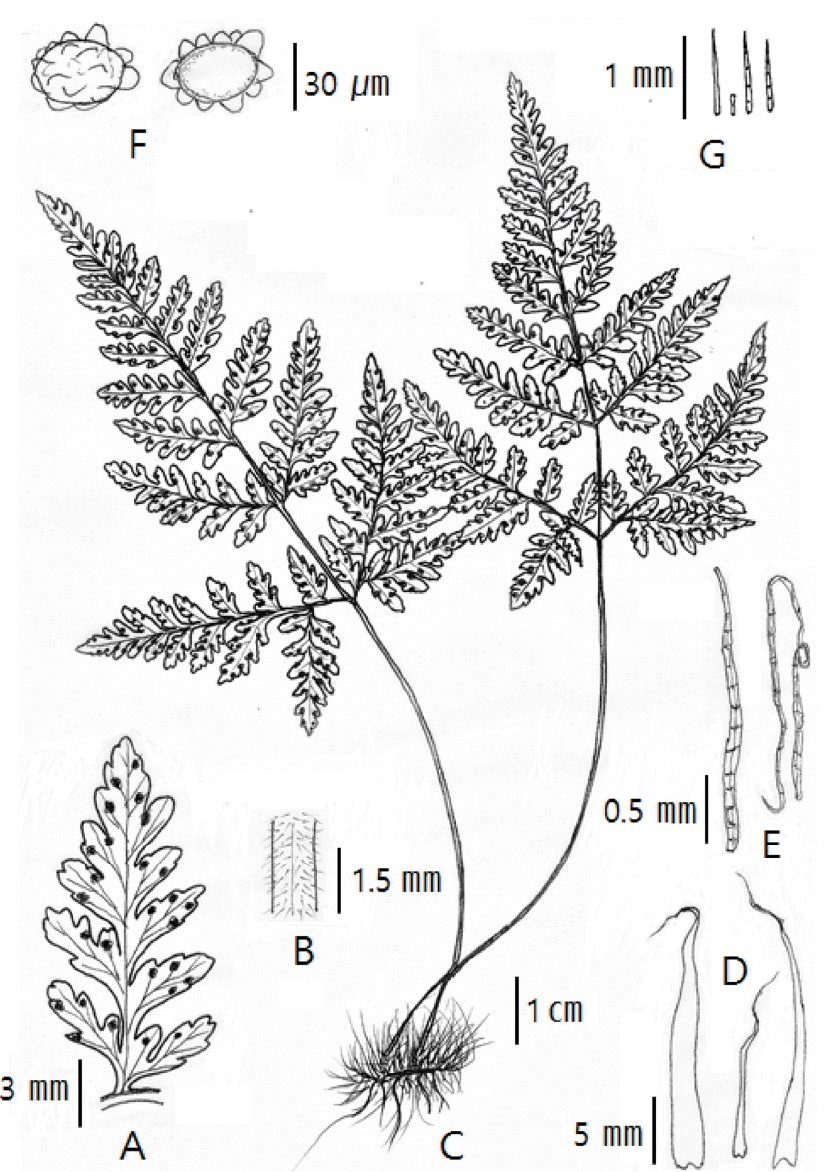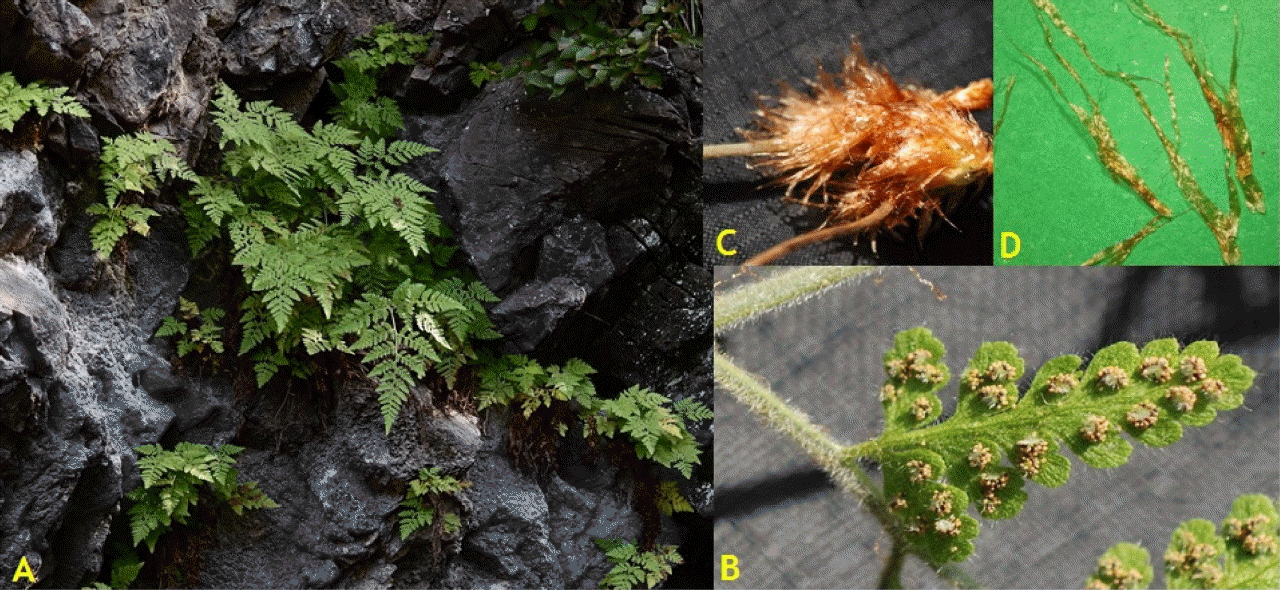한반도 미기록 식물: 흰금털고사리(금털고사리과)
First record of Hypodematium squamuloso-pilosum Ching (Hypodematiaceae) from Korea
Article information
Trans Abstract
A new unrecorded species, Hypodematium squamuloso-pilosum Ching (Hypodematiaceae), previously known only in China, was newly found on the rocks of a limestone mountain in Yeongwol-gun, Gangwondo, Korea. This taxon is distinguished from H. glanduloso-pilosum (Tagawa) Ohwi, reported as a species of Hypodematium in Korea based on linear lanceolate scales on the rhizome and a stipe base, white long hairs throughout the leaves, rarely reddish brown curly linear scales on the stipe, and oblong-lanceolate basal pinna. This taxon was most similar to H. hirsutum based on the plant height, rhizome, scale shape and size, sori position, and indusium shape. A new Korean name, ‘Huin-geum-teol-go-sa-ri’, was given based on the long white hair throughout. Descriptions and illustrations of this taxon and a photograph of its habitat are provided from Korea.
The genus Hypodematium Kunze was firstly recognized as four species, including one subspecies, by Iwatsuki (1964). It currently consists of 18 species distributed in rock crevices of limestone areas among mostly subtropical and warm-temperate regions of Asia and Africa, and 12–14 species are distributed in China (Shing et al., 1999; Zhang and Iwatsuki, 2013; Wang et al., 2014). This genus is well characterized by growth on limestone rocks, having short rhizome and swollen base of stipe densely covered with scales, stipes and laminae usually with acicular long hairs, mixed glandular hairs or glabrous, largest basal pinnae, and chromosome number x = 41 (Shing et al., 1999; Zhang and Iwatsuki, 2013; Wang et al., 2014). Opinions about the status of the genus Hypodematium were used differently by Dryopteridaceae (Loyal, 1960; Tryon and Tryon, 1982; Kramer et al., 1990; Smith et al., 2006; Liu et al., 2007), Thelypteridaceae (Ching, 1963), and Athyriaceae (Pichi Sermolli, 1977). Hypodematiaceae firstly devised by Ching (1975) includes the genus Hypodematium as the majority genus (Wang et al., 2014), and this family is defined by one unique genus, Hypodematium, or three genera (Hypodematium, Didymochlaena, Leucostegia). It has been suggested that Hypodematiaceae is a monophyletic family based on molecular study (Christenhusz et al., 2011).
The genus Hypodematium in Korea was known to be distributed just one species, H. glanduloso-pilosum (Tagawa) Ohwi, with a simple species description (Park, 1975; Lee, 1980; Lee, 2006; Korea National Arboretum, 2008; Kim and Sun, 2015; Lee and Lee, 2015).
We identified an additional species, Hypodematium squamuloso-pilosum Ching, with about 100 individuals per 10 m2. It is reported as a newly recorded taxon from Korea and was collected from rocks of a limestone mountain in Yeongwol-gun, Gangwon-do. The local name was designated as ‘Huin-geum-teol-go-sa-ri’ based on its habitat. We compared and analyzed morphological characters between H. squamuloso-pilosum and similar interspecific taxa of Hypodematium to elucidate their taxonomic relationship. Morphological characters and illustrations of H. squamuloso-pilosum, along with photographs of the habitat, are newly reported to the species of Hypodematium from Korea.
Taxonomic Treatment
Hypodematium squamuloso-pilosum Ching
Korean name: Huin-geum-teol-go-sa-ri (흰금털고사리) (Figs. 1, 2).

Illustrations of Hypodematium squamuloso-pilosum Ching, taken in a limestone forest at Yeongwol-gun, Gangwon-do, Korea, 24 Sep 2016. A. Sori and indusium in pinnules. B. Hairs in stipe. C. Habit. D. Scales in rhizome and stipe base. E. Sparse scales in stipe and rachis. F. Spore. G. White and long hairs.

Photographs of Hypodematium squamuloso-pilosum Ching, taken in a limestone forest at Yeongwol-gun, Gangwon-do, Korea, 24 Sep 2016. A. Habit. B. Indusia and sori in pinnule, and densely white long hairs in rachis and pinnule. C. Stipe base and rhizome covered with densely scales. D. Linear lanceolate scales in stipe base and rhizome.
Herbs, mostly rupestral, 12–30 tall. Rhizomes shortly creeping, 1–2 mm in diameter, densely scaly; scales linear to narrowly lanceolate, 10–17 × 1.0×1.7 mm, reddish brown, lustrous, membranous. Stipes 5–23 cm long, stramineous, densely scaly on swollen base, densely grayish white hairy, rarely mixed with curly, linear scales at upward. Lamina 3–4 pinnatifid, ovate-oblong, base cordate, apex acuminate, herbaceous, 8–15 × ca. 7–12 cm, densely white long hairy on rachis and costae, sometimes mixed with glandular hairs and curly, linear, reddish brown scales. Pinnae 8–12 pairs, lower pairs 2–4 cm apart, basal pair almost opposite and largest, oblong lanceolate, apex shortly acuminate, 2–3 pinnatifid, base cordate, 5–8 × 2.5–3.5 cm, basal pinnae shortly stalked. Pinnules 7–9 pairs, alternate, anadromous, shortly stalked, upper ones smaller, apex round or obtuse, margins serrate. Veins free, simple, ending at margin. Sori orbicular, 1–4 per segment, located on the middle of veinlets. Indusia reniform, persistent, almost entire or somewhat serrate at margin, densely covered with hairs.
Habitat: In rocks of limestone regions within forests.
Distribution: Yeongwol-gun, Gangwon-do, Korea.
Specimens examined: KOREA. Gangwon-do: Yeongwol-gun, Hanbando-myeon, elev. 240 m, 24 Sep 2016, C.S. Lee & K. Lee 16092401 (EWH [4 sheets], KH [3 sheets], KB [3 sheets]; 28 Oct 2013, K. Lee & M.K. Lee 13102801 (KH [1 sheet]).
Taxonomic notes: The newly reported taxon in Korea, Hypodematium squamuloso-pilosum is known as an endemic in China (Zhang and Iwatski, 2013) but was found first in Gangwon-do in Korea.
The new local name ‘Huin-geum-teol-go-sa-ri’ was given based on its having throughout long white hairy. It was firstly found with Cornus walteri, Fraxinus rhynchophylla, Celtis koraiensis, Lespedeza maximowiczii, Ulmus davidiana var. japonica, Juniperus rigida, Aster scaber, and Commelina communis in a forest in Hanbando-myeon, Yeongwol-gun, Gangwon-do.
This taxon is distinguished from H. glanduloso-pilosum (Tagawa) Ohwi reported as one species of Hypodematium in Korea based on scales in rhizome and stipe base linear to narrowly lanceolate, white long hairs throughout leaves, rarely reddish brown curly linear scales on stipe, and basal pinna oblong-lanceolate.
The chromosome numbers of H. squamuloso-pilosum and H. hirsutum have the same type as n = 41 (41 II) based on cytotaxonomic study by Wang et al. (2014). This taxon firstly described from Korea was most similar with H. hirsutum distributed in China, Bhutan, India, Myanmar, and Nepal based on rhizome, scale shape and size, sori position, and hairs in indusia (Iwatsuki, 1992, 1995; Wang et al., 2010; Zhang and Iwatsuki, 2013) (Table 1). Hypodematium fordii distributed in China and Japan was also similar with H. squamuloso-pilosum, but the former has different characters from the latter based on almost glabrous upward in stipe, densely glandular hairs in lamina, triangular ovate basal pinna, and sparsely glandular hairs in indusia (Table 1).

Comparative morphological characters between Hypodematium squamuloso-pilosum Ching, and related species distributed in China and Japan of Hypodematium (Iwatsuki, 1992; Wang et al., 2010; Zhang and Iwatsuki, 2013).
Furthermore, it was distinguished from other taxa of the genus Hypodematium the distinct characters such as densely long hairs throughout the leaf and sparsely with glandular hairs and reddish brown curly linear scales, and basal pinna oblong lanceolate (Table 1).